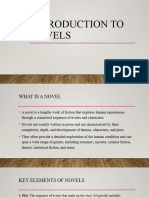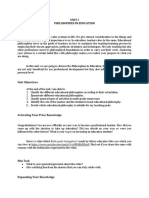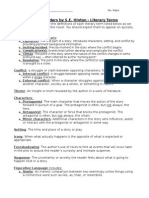0 ratings0% found this document useful (0 votes)
91 viewsModule 7
The document discusses tone in writing and discusses the following key points:
1) Tone is the author's attitude toward the reader and subject matter. It affects how the reader perceives the written message.
2) When writing, the author considers tone by making choices about diction, syntax, and sentence structure. The tone comes through in elements like dialogue and character actions.
3) There are different points of view (POVs) an author can use like first, second, and third person that impact the narrative voice/tone. The POV should be carefully considered.
Uploaded by
Mhaebilyn DizonCopyright
© © All Rights Reserved
Available Formats
Download as PPTX, PDF, TXT or read online on Scribd
0 ratings0% found this document useful (0 votes)
91 viewsModule 7
The document discusses tone in writing and discusses the following key points:
1) Tone is the author's attitude toward the reader and subject matter. It affects how the reader perceives the written message.
2) When writing, the author considers tone by making choices about diction, syntax, and sentence structure. The tone comes through in elements like dialogue and character actions.
3) There are different points of view (POVs) an author can use like first, second, and third person that impact the narrative voice/tone. The POV should be carefully considered.
Uploaded by
Mhaebilyn DizonCopyright
© © All Rights Reserved
Available Formats
Download as PPTX, PDF, TXT or read online on Scribd
You are on page 1/ 8
Intonation (or varied tone) is used in
speech to determine what message you
want to convey. The patterns of voice
include the following:
Rising action Example: “Are you ready to
listen?”
Falling action Example: “When are you going
to listen?”
Fall-rise action Example: “Would you like to
listen?”
In literature, tone is the approach of the author
on his or her writing. Tone is not only set in
fictional works. It is also apparent in essays.
Scott Ober, author of Contemporary Business
Communication, defined tone as “the writer’s
toward the reader and the subject of the
message. The overall tone of a written message
affects the reader just as one’s tone voice affects
the listener in everyday exchanges.”
Before you write your piece, starting from the topic or
theme and the character or conflict, you already have
imposed your biases and drawn limits – including your
political views, gender identity, religion, ethnicity,
notions, etc. It also includes who your target audience is
and what medium you are going use.
Tone is as important as other elements in Creative Non
Fiction. “Of course,” Philip Gerard, co-author of Writing
Creating Nonfiction said, “the author has been with us in
every line, in the second way that an author participates
in a nonfiction story: tone.”
In setting the tone of your writing, you consider
your diction (choice of words), syntax
(arrangement of words), and sentence
structure (construction of sentences). The tone
is evident in the speaker, dialogue, flow of the
story, and actions of each character. Although
there is general tone to a general tone to a
literary work, the tone may change based on the
development of the story, the scenes, and the
characters.
The tone of your voice affects the reader’s
perceptions of your work. Your writer’s
voice, in general, is your style of writing
that you develop through time.
The narrative voice is the voice of your
work’s speaker (narrator persona). It is
called authorial voice. That is why it is
important for you to decide on what angel
of vision, whose POV your story will be
told.
Here is a rundown of the POVs and how you can use
the in Creative Non Fiction:
a). FIRST-PERSON POV
Though the literary work is signified by the use of I
or we, you have learned from fiction writing that the
speaker –the authorial voice- is not necessarily the
main character or the author himself or herself.
Writing in the first person means that you have to be
mindful of the language register of the narrator.
Consider, for example, this part from Alice Waler’s
epistolary novel The Color Purple.
b). SECOND-PERSON POV
It is signified by the use of you. Poet Jillian M. Phillips pointed
out that “the use of second person-‘you’-is rare in fiction, but is fairly
common in poetry”. In this case, that “you” is combined with the “I”.
In the fiction writing, you have to make sure to whom the “you”
pertains. Your reader will automatically become the surrogate – as a
part of the narrative. If the perspective of the character is not detailed
enough, you will lead your readers astray. Consider the poem “Full
Metal Jacket” written by Mark Angeles. The “you” in this poem was
seven-year-old Stephanie Nicole Ella. She was a victim of a stray
bullet. That was detailed at the end of the poem. But for someone who
had read it for the first time, the person may have difficulty
connecting with the narrative.
c). THIRD-PERSON POV
This POV is signified by the use of the pronouns he, she, it, or they. The
speaker is not one of the characters of the narrative. The character does not
participate in the flow of the story, and is, therefore, not affected by it. As
you have learned, there are three ways of writing the third-person POV.
1. Objective – the speaker gives an unbiased POV, knows or reveals
nothing about the characters’ internal thoughts, feelings, and motivations
and sticks to the external facts of the story.
2. Limited Omniscient – the speaker knows the internal thoughts, opinions,
feelings and motivations of one character only (usually the main character),
which means anything the character does not know about, the narrator
cannot tell.
3. Omniscient – the speaker knows, and at least partially reveals, the
internal thoughts, opinions, feelings, and motivations of all the characters,
describes almost everything about the places and events of the story.
You might also like
- GR 10 SBA - TASK 8 Literature Assignment - Learner's Task QP63% (8)GR 10 SBA - TASK 8 Literature Assignment - Learner's Task QP6 pages
- Chesapeake College Writing Center Writing A Literary AnalysisNo ratings yetChesapeake College Writing Center Writing A Literary Analysis4 pages
- Narrative Conventions and Language Devices For English StudentsNo ratings yetNarrative Conventions and Language Devices For English Students18 pages
- An Analysis of The Main Character of Jane AustenNo ratings yetAn Analysis of The Main Character of Jane Austen9 pages
- 1 Literary Text Close Analysis and Critical Interpretation PDFNo ratings yet1 Literary Text Close Analysis and Critical Interpretation PDF63 pages
- Element's of Literature and Figure of SpeechNo ratings yetElement's of Literature and Figure of Speech15 pages
- The Type of Viewpoint and The Theme in A Orientation' Short Story by Daniel OrozcoNo ratings yetThe Type of Viewpoint and The Theme in A Orientation' Short Story by Daniel Orozco8 pages
- Jahn, Manfred - Narratology-A Guide To The Theory of Narrative PDF100% (1)Jahn, Manfred - Narratology-A Guide To The Theory of Narrative PDF84 pages
- How to Craft Killer Dialogue for Fiction & Creative Non-Fiction: Writer Productivity Series, #3From EverandHow to Craft Killer Dialogue for Fiction & Creative Non-Fiction: Writer Productivity Series, #3No ratings yet
- Assessment Terminlogies and Principles of High Quality AssessmentNo ratings yetAssessment Terminlogies and Principles of High Quality Assessment10 pages
- Semi-Detailed Lesson Plan: Factors in Managing A Business: Buying Products and Selling ProductsNo ratings yetSemi-Detailed Lesson Plan: Factors in Managing A Business: Buying Products and Selling Products3 pages
- MODULE 9 - Socio-Emotional Development of Infants and ToddlersNo ratings yetMODULE 9 - Socio-Emotional Development of Infants and Toddlers23 pages
- Impacts of Facebook As Recreational Enjoyment PercNo ratings yetImpacts of Facebook As Recreational Enjoyment Perc1 page
- Dictionary, Is "A Form of Expression Natural Do ANo ratings yetDictionary, Is "A Form of Expression Natural Do A11 pages
- Drama Is Composition in Prose Form That Presents A StoryNo ratings yetDrama Is Composition in Prose Form That Presents A Story11 pages
- Poetry: When You Read The Word Poetry', What Comes To Your Mind? Write at Least 5-7 Words in The Rays of The Sun BelowNo ratings yetPoetry: When You Read The Word Poetry', What Comes To Your Mind? Write at Least 5-7 Words in The Rays of The Sun Below6 pages
- Gagarin - Dike in Archaic Greek ThoughtNo ratings yetGagarin - Dike in Archaic Greek Thought13 pages
- Perpertual Succour Academy, Inc.: Teacher-Made Learner's Home TaskNo ratings yetPerpertual Succour Academy, Inc.: Teacher-Made Learner's Home Task3 pages
- Buy ebook Smart, Resilient and Transition Cities: Emerging Approaches and Tools for A Climate-Sensitive Urban Development 1st Edition Adriana Galderisi cheap price100% (5)Buy ebook Smart, Resilient and Transition Cities: Emerging Approaches and Tools for A Climate-Sensitive Urban Development 1st Edition Adriana Galderisi cheap price41 pages
- Car12 q1 Mod5 Evaluating Contemporary Art FormsNo ratings yetCar12 q1 Mod5 Evaluating Contemporary Art Forms19 pages
- Algebraic Topology 1st Edition C. R. F. Maunder - The latest updated ebook version is ready for downloadNo ratings yetAlgebraic Topology 1st Edition C. R. F. Maunder - The latest updated ebook version is ready for download47 pages
- Childhood in History Perceptions of C... (Z-Library)No ratings yetChildhood in History Perceptions of C... (Z-Library)400 pages
- The Voyaging Reality Maria Izquierdo andNo ratings yetThe Voyaging Reality Maria Izquierdo and12 pages
- Basic Blueprint Reading and Sketching 9th Edition Thomas P. Olivo - The ebook is available for quick download, easy access to content100% (1)Basic Blueprint Reading and Sketching 9th Edition Thomas P. Olivo - The ebook is available for quick download, easy access to content54 pages
- Characters Conflict: The Scent of ApplesNo ratings yetCharacters Conflict: The Scent of Apples1 page
- To all the boys I've loved before presentationNo ratings yetTo all the boys I've loved before presentation7 pages
- (Birmingham Byzantine and Ottoman Studies) Margaret Mullett - Theophylact of Ochrid - Reading The Letters of A Byzantine Archbishop-Routledge (1997)No ratings yet(Birmingham Byzantine and Ottoman Studies) Margaret Mullett - Theophylact of Ochrid - Reading The Letters of A Byzantine Archbishop-Routledge (1997)462 pages
- The Art of Protest Culture and Activism from the Civil Rights Movement to the Streets of Seattle 1st Edition T.V. Reed all chapter instant download100% (29)The Art of Protest Culture and Activism from the Civil Rights Movement to the Streets of Seattle 1st Edition T.V. Reed all chapter instant download60 pages
- Teach Self-Control: Teaching Outline For KEY #6 Part 2: Preventive Guidance TechniquesNo ratings yetTeach Self-Control: Teaching Outline For KEY #6 Part 2: Preventive Guidance Techniques6 pages
- Little Bunny - S Sleepless Night - SalesSampleNo ratings yetLittle Bunny - S Sleepless Night - SalesSample21 pages
- GR 10 SBA - TASK 8 Literature Assignment - Learner's Task QPGR 10 SBA - TASK 8 Literature Assignment - Learner's Task QP
- Chesapeake College Writing Center Writing A Literary AnalysisChesapeake College Writing Center Writing A Literary Analysis
- Narrative Conventions and Language Devices For English StudentsNarrative Conventions and Language Devices For English Students
- 1 Literary Text Close Analysis and Critical Interpretation PDF1 Literary Text Close Analysis and Critical Interpretation PDF
- The Type of Viewpoint and The Theme in A Orientation' Short Story by Daniel OrozcoThe Type of Viewpoint and The Theme in A Orientation' Short Story by Daniel Orozco
- Jahn, Manfred - Narratology-A Guide To The Theory of Narrative PDFJahn, Manfred - Narratology-A Guide To The Theory of Narrative PDF
- How to Craft Killer Dialogue for Fiction & Creative Non-Fiction: Writer Productivity Series, #3From EverandHow to Craft Killer Dialogue for Fiction & Creative Non-Fiction: Writer Productivity Series, #3
- Assessment Terminlogies and Principles of High Quality AssessmentAssessment Terminlogies and Principles of High Quality Assessment
- Semi-Detailed Lesson Plan: Factors in Managing A Business: Buying Products and Selling ProductsSemi-Detailed Lesson Plan: Factors in Managing A Business: Buying Products and Selling Products
- MODULE 9 - Socio-Emotional Development of Infants and ToddlersMODULE 9 - Socio-Emotional Development of Infants and Toddlers
- Impacts of Facebook As Recreational Enjoyment PercImpacts of Facebook As Recreational Enjoyment Perc
- Drama Is Composition in Prose Form That Presents A StoryDrama Is Composition in Prose Form That Presents A Story
- Poetry: When You Read The Word Poetry', What Comes To Your Mind? Write at Least 5-7 Words in The Rays of The Sun BelowPoetry: When You Read The Word Poetry', What Comes To Your Mind? Write at Least 5-7 Words in The Rays of The Sun Below
- Perpertual Succour Academy, Inc.: Teacher-Made Learner's Home TaskPerpertual Succour Academy, Inc.: Teacher-Made Learner's Home Task
- Buy ebook Smart, Resilient and Transition Cities: Emerging Approaches and Tools for A Climate-Sensitive Urban Development 1st Edition Adriana Galderisi cheap priceBuy ebook Smart, Resilient and Transition Cities: Emerging Approaches and Tools for A Climate-Sensitive Urban Development 1st Edition Adriana Galderisi cheap price
- Algebraic Topology 1st Edition C. R. F. Maunder - The latest updated ebook version is ready for downloadAlgebraic Topology 1st Edition C. R. F. Maunder - The latest updated ebook version is ready for download
- Childhood in History Perceptions of C... (Z-Library)Childhood in History Perceptions of C... (Z-Library)
- Basic Blueprint Reading and Sketching 9th Edition Thomas P. Olivo - The ebook is available for quick download, easy access to contentBasic Blueprint Reading and Sketching 9th Edition Thomas P. Olivo - The ebook is available for quick download, easy access to content
- (Birmingham Byzantine and Ottoman Studies) Margaret Mullett - Theophylact of Ochrid - Reading The Letters of A Byzantine Archbishop-Routledge (1997)(Birmingham Byzantine and Ottoman Studies) Margaret Mullett - Theophylact of Ochrid - Reading The Letters of A Byzantine Archbishop-Routledge (1997)
- The Art of Protest Culture and Activism from the Civil Rights Movement to the Streets of Seattle 1st Edition T.V. Reed all chapter instant downloadThe Art of Protest Culture and Activism from the Civil Rights Movement to the Streets of Seattle 1st Edition T.V. Reed all chapter instant download
- Teach Self-Control: Teaching Outline For KEY #6 Part 2: Preventive Guidance TechniquesTeach Self-Control: Teaching Outline For KEY #6 Part 2: Preventive Guidance Techniques











































































































